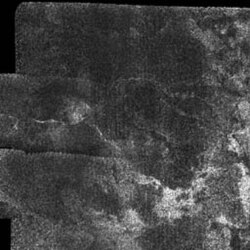
Haidinger's brush, more commonly known as Haidinger's brushes is an image produced by the eye, an entoptic phenomenon, first described by Austrian physicist Wilhelm Karl von Haidinger in 1844. Haidinger saw it when he looked through various minerals that polarized light.

A geodesic dome is a hemispherical thin-shell structure (lattice-shell) based on a geodesic polyhedron. The triangular elements of the dome are structurally rigid and distribute the structural stress throughout the structure, making geodesic domes able to withstand very heavy loads for their size.

The Lick Observatory is an astronomical observatory owned and operated by the University of California. It is on the summit of Mount Hamilton, in the Diablo Range just east of San Jose, California, United States. The observatory is managed by the University of California Observatories, with headquarters on the University of California, Santa Cruz campus, where its scientific staff moved in the mid-1960s. It is named after James Lick.

The macula (/ˈmakjʊlə/) or macula lutea is an oval-shaped pigmented area in the center of the retina of the human eye and in other animals. The macula in humans has a diameter of around 5.5 mm (0.22 in) and is subdivided into the umbo, foveola, foveal avascular zone, fovea, parafovea, and perifovea areas.

The fovea centralis is a small, central pit composed of closely packed cones in the eye. It is located in the center of the macula lutea of the retina.
This is a partial list of human eye diseases and disorders.

Macular degeneration, also known as age-related macular degeneration, is a medical condition which may result in blurred or no vision in the center of the visual field. Early on there are often no symptoms. Over time, however, some people experience a gradual worsening of vision that may affect one or both eyes. While it does not result in complete blindness, loss of central vision can make it hard to recognize faces, drive, read, or perform other activities of daily life. Visual hallucinations may also occur but these do not represent a mental illness.

Vitelliform macular dystrophy is an irregular autosomal dominant eye disorder which can cause progressive vision loss. This disorder affects the retina, specifically cells in a small area near the center of the retina called the macula. The macula is responsible for sharp central vision, which is needed for detailed tasks such as reading, driving, and recognizing faces. The condition is characterized by yellow, slightly elevated, round structures similar to the yolk of an egg.
In the physiology of the kidney, tubuloglomerular feedback (TGF) is a feedback system inside the kidneys. Within each nephron, information from the renal tubules is signaled to the glomerulus. Tubuloglomerular feedback is one of several mechanisms the kidney uses to regulate glomerular filtration rate (GFR). It involves the concept of purinergic signaling, in which an increased distal tubular sodium chloride concentration causes a basolateral release of adenosine from the macula densa cells. This initiates a cascade of events that ultimately brings GFR to an appropriate level.

Basohli is a town near Kathua in Kathua district in the union territory of Jammu and Kashmir, India. It is situated on the right bank of River Ravi at an altitude of 1876 ft. It was founded by Raja Bhupat Pal sometime in 1635. It was known for the palaces which are now in ruins and miniatures paintings. The Battle of Basoli was fought in this region.

Panchayatana puja also known as Pancha Devi Deva Puja is a system of puja (worship) in the Smarta sampradaya, which is one of four major sampradaya of Hinduism. It consists of the worship of five deities set in a quincunx pattern, the five deities being Ganesha, Shakti, Shiva, Vishnu and Surya. Sometimes an Ishta Devata or Kartikeya is the sixth deity in the mandala.

The Ganesha Purana is a Sanskrit text that deals with the Hindu deity Ganesha. It is an upapurāṇa that includes mythology, cosmogony, genealogy, metaphors, yoga, theology and philosophy relating to Ganesha.
Ganesha is a Hindu deity of intellect and wisdom.

The marital status of Ganesha varies widely in mythological stories and the issue has been the subject of considerable scholarly review. Several patterns of associations with different consorts are identifiable. One pattern of myths identifies Ganesha as an unmarried brahmacārin with no consorts. Another mainstream pattern associates him with the concepts of Buddhi (intellect), Siddhi, and Riddhi (prosperity); these qualities are sometimes personified as goddesses who are considered to be Ganesha's wives. Another pattern connects Ganesha with the goddess of culture and the arts, Sarasvati. In the Bengal region he is linked with the banana tree, Kala Bo. Usually Ganesha's consort is portrayed as his shakti, a personification of his creative energy.

The Brighton Dome Studio Theatre is a theatre in Brighton, England. It is part of the wider Brighton Dome complex of buildings. It was built in 1935, originally as a supper room, but later converted into a theatre. Its audience capacity is 232 seated or 350 standing.

Ganesha, also known as Ganapati,Vinayaka, and Pillaiyar, is one of the best-known and most worshipped deities in the Hindu pantheon and is the Supreme God in Ganapatya Sect. His image is found throughout India. Hindu denominations worship him regardless of affiliations. Devotion to Ganesha is widely diffused and extends to Jains and Buddhists and includes Nepal, Sri Lanka, Thailand, Indonesia, Singapore, Malaysia, Philippines, and Bangladesh and in countries with large ethnic Indian populations including Fiji, Guyana, Mauritius, and Trinidad and Tobago.
Jalesvara Siva Temple Precinct is a Hindu Temple dedicated to Shiva situated on the southern outskirt of the village Kalarahanga at a distance of 2.00 km from Patia and 6.00 km south of Chudangagada in the northern outskirt of Bhubaneswar, Odisha, India. The presiding deity is a Siva-lingam within a circular yonipitha inside the sanctum, which is 1.15 meters below the chandrasila. The sanctum measures 2.00 square meters.
Jatakalankara is a brief Sanskrit treatise comprising one hundred twenty-five slokas or verses on the predictive part of Hindu astrology written in the classic Sloka format in the Srgdhara meter. It was written by Poet Ganesa, son of Gopal Das, in the year 1613 and describes many yoga-formations that have immediate bearing on various aspects of human life. Ganesha wrote this treatise to please his Guru Shiva Its first translation into English was probably published, along with the original text, in 1941 by Sri Vijay Lakshmi Vilas Press.

Cthulhu Macula is a prominent surface feature of the dwarf planet Pluto, that is reminiscent of a whale in shape. It is an elongated dark region along Pluto's equator, 2,990 km (1,860 mi) long and one of the darkest features on Pluto. It is west of the Sputnik Planitia region of Tombaugh Regio, also known as Pluto's "heart", and to the east of Meng-P'o, the easternmost of Pluto's "Brass Knuckles".














